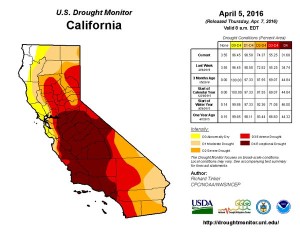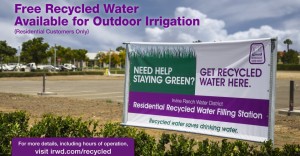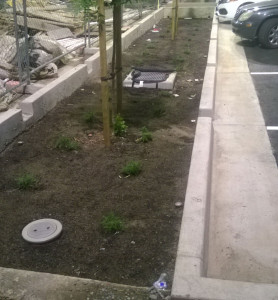Dear California Governor Jerry Brown,
As we await your decision to end the drought or lower its severity as reservoirs in Northern California are nearing full capacity and the Sierra Nevada shows signs of an ample snow pack; I come with an idea to appeal to your senses.
My recommendation:
Declare the drought is over if a homeowner doesn’t have grass in front yard.
If a homeowner has grass, drought rules and its current fees/fines will continue.
What determines grass? Lawn, in the most common sense of the word. A field of weeds doesn’t count.
Why such extremes? The state has spent hundreds of millions in tax dollars converting lawns to gardens by way of money per square foot of lawn removed. Their removal has greatly reduced demands on potable water distribution systems, but there are still plenty of lawns remaining.
Homeowners everywhere are looking to you for direction. We’ve seen the articles of people with dead lawns and talking about full reservoirs and still 25% mandatory water use reductions. So how do lower potable water demands and appease homeowners water bills? By implementing my suggestion above.
I’ve described 5 aspects to the program – how it works, how to implement it, exemptions, benefits of the program and how to enforce it. They’ve been described in detail below.
How the program works:
Announcing the drought ending is a three part process.
- “Drought is over for anyone without grass in their front yard.” This will appeal to everyone that removed their lawn or never had one in the first place. They have already seen the benefits of less outdoor irrigation on their water bill and can enjoy reduced fees for less water used. These people are your biggest advocates for lawn removal programs and you should honor them for making the switch.
- “Drought continues for anyone with grass in their front yard, drought related surcharges remain the same or increase (per water agency).” Yes this makes grass a scapegoat for the drought, just like almond trees were last year. The option created here is homeowners could lower their water bill (or not being named in the newspaper) if they removed their lawn.
- “Drought rules extended to businesses, municipalities and HOA’s.” Homeowners were penalized last year for the drought, this year we demand businesses, municipalities and HOA’s are on the hook too. There are far too many shopping centers and business parks that waste vast quantities of water every night by flooding lawns and gutters. This practice must stop and non-essential grass should be removed.
How will the program be implemented?
Once you make your drought update announcement at the end of May, notify every water provider in the state they have 2 billing cycles to comply (in the mean time, all current drought rules still apply).
Direct water agencies to include a check-box on water bills (or online water bill payment system) that says the homeowner or business doesn’t have a lawn in front of their property. If they don’t check the box, then they’re automatically included in current drought rules as having grass.
Homeowners or businesses that say they don’t have grass, are dropped to rates before the drought. All drought related fees and surcharges are dropped. If the water agency was deemed to have rules put in place for high water users information to be released to the public, that information would become private again for homeowners.
How will truthfulness be checked? Employees of the water agency (think of the same department that checks on homes that did the Lawn to Garden program) are allowed to investigate whether a customers check in the box is truthful. If a homeowner is found to be lying about not having grass, but in reality does, the homeowner will be fined $500 for falsifying state documents.
A quick and simple process will need to be setup to allow the homeowner a chance to refute the claim. The monies paid for the fine will go towards implement a lawn to garden, rainwater harvesting or on-site grey-water recycling classes in that community.
Program exemptions:
There are four items that can used as exemptions. A property owner with these items would have the drought rules relaxed and move to a non-drought rate plan from their water company. This list is not complete, but is a perfect avenue to start the conversation.
- Recycled water used for irrigation, either direct plumb, residential haulers or on-site grey water reuse. Recycled water has gained approval by nearly 89% of residents. It is a drought proof resource and generally doesn’t meet water quality requirements for drinking. Thus it becomes perfect for irrigation. Also, every residential recycled water fill station keeps a record of where water is being used. Homeowners that put in the time and effort to haul water shouldn’t have to pay drought surcharges for using much less water and keeping their landscapes alive. Same goes for homeowners or businesses that utilize grey water recycling.
- Rainwater harvesting installed to limit run-off (swales, cisterns, bio-retention basins). We’ve seen the benefits of plumbing rainwater from the roof to the ground versus directing it to the street means our gardens have less demand on potable water systems for irrigation. Plus, saving rainwater on property and using for irrigation slows the flow of pollutants off our property and into storm drains and the ecosystem.
- Homeowners on wells. Homeowners that use well water for irrigation and still connected to the municipal potable water distribution system should also have their drought surcharges reduced.
- Low Income Communities – Not every community can afford the drought surcharges, homeowners in low income communities should be given a reprieve.
Expected Benefits:
The ultimate goal of this program is to build long-term solutions at homes or businesses for a water conscience landscape. Using the exemptions listed above is the first step in that direction. Below is a list of some of those expected benefits.
- Raise awareness to recycled water for irrigation – either drum up demand for recycled water pipelines to be installed from wastewater treatment plants – and perhaps find an avenue for homeowners and businesses to help pay for pipeline installations.
- Raise awareness to rainwater harvesting – cities and municipalities have building codes in place for reduce pollution from streets and parking lots. Homeowners can save water from their roof’s to use on dry days or plumb downspouts to the land to increase the water table, which has been severely depleted from over-pumping from wells.
- New inclusion of businesses and HOA’s to 2015 drought rules – this was an item left out last year and should have been added.
- Homeowners that have followed your rules can reduce stress and public scrutiny to stay under drought mandate requirements.
- Heavy water users pay more for their demands on the potable water system than non.
Program enforcement:
Every billing cycle, let the the homeowner check the box if they’ve removed their lawn and put in a garden or installed one of the above mentioned exemption options. In order to receive the reduced rates, the water agency will need to check to see if their change meets program requirements.
Upon successful implementation, paying customers drop to non-drought rate structures.
Let the program run for a year and re-assess. I’ve mentioned this idea to a few people in the water industry and everyone loves it. I hope you will too.
Signed,
Nick
Founder of RecycledH2O.net






Leave a Reply